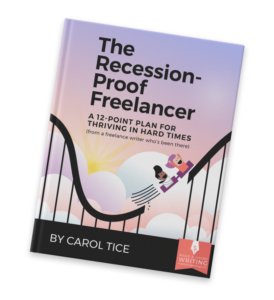Do you find yourself stuck writing for clients on days you wanted off, or for rates you don’t like? Maybe if you’re a newbie, you’re worried that you’ll get trapped doing a zillion rounds of edits, while your hourly rate goes down the tubes. If you’re one of those people who have a hard time saying ‘no’ to people, you could find these problems cropping up a lot.
Letting boundary-pushing clients walk all over you leads to lower earnings, so you’re going to want to avoid these scenes. Fortunately, there’s an easy way to stop clients from taking advantage of you–one that avoids confrontations and keeps things humming.
How do pro writers get problem clients to fall in line, with little effort? It’s simple: They have rules for their writing business. And they consistently follow them. Here are some of the best boundaries for writers.
Open for business?
You’ve probably noticed that you can’t visit your favorite clothing boutique to try things on whenever you get in the mood. You have to come when they’re open. They’ve created rules for their hours of operation that their customers have to follow.
Well, guess what: You’re a business too! Sure, yours may be based at your kitchen table.
That doesn’t mean your business doesn’t need rules. It does. Otherwise, you’ll go nuts trying to create appropriate boundaries for each new client.
That’s my policy
Here’s the magic of having business rules: You feel empowered to tell your client what those rules are, and to make them stick to those. Because they’re always the same, it becomes routine. You don’t feel weird or scared to say ‘Hey, please stop calling me at 9 p.m. on Saturdays.’ It’s straightforward, because that is your policy. Not singling you out or anything…this is simply how it is.
Having rules makes defining your boundaries nothing personal. It’s just how I do business. Sorry, can’t be helped, that’s the policy.
This avoids your having to say things like, ‘I’m giving you this rule because you’re a boundary-pusher who’s consuming every molecule of oxygen in my world, and I need to cut you off.’ That’s a much more difficult conversation to have.
Am I about to tell you what your rules should be? Nope.
It’s your business to run. Only you can decide what feels fair to you, and is within your bandwidth to get done.
What I can give you is the basic categories of business operations around which you should create rules. Have a think on these.
To help you with this, I’m sharing my own rules below. I’ve also asked some graduates of my proven income-doubling program, Freelance Writers Den 2X Income Accelerator, to share their rules, too. I think between the categories and examples below, you’ll get a good sense of how to protect your business–and your sanity–with some basic ground rules.

7 Boundaries for Writers
What rules should you define for your freelancing business, so that when you talk to clients you don’t get taken? Here are seven basic categories to consider–with my own rules for each included:
1. Know your rates
What are you going to charge? It’s better to come in knowing, so you don’t get talked into working for too little.
Possibly the most frequently asked question on this blog in its decade-plus of existence is ‘What should I charge?’ The better question to ask is how you should charge.
Ideally, you want to charge by the project. We aren’t clerks, so we don’t want to work by the hour unless it’s impossible to calculate how much time will be needed. Charging by the word is even worse–as if the number of words expresses the value of your knowledge. Also, do you want to sit around counting words, waiting for your piece to finalize so you can tally up the words to send your bill? No, you don’t.
Track your time and figure out a project fee that will get you the hourly rate you want. For new writers in any developed nation, $35/hr.-$50/hr. is a good starting point. From there, raise your rates until you’re above $75-$100 an hour (I’m shooting for north of this now). That’s where the pros live.
Don’t know how long it takes you to write things? Start tracking your time and find out. That’s how I developed my hourly rates, by knowing how long projects take me.
This section is called ‘know your rates’ instead of ‘say your rates,’ because only you need to know your hourly rate. Tell the client the project fee. Not really their business how long it takes you to do things. Do the math behind the scenes with your hourly rate to come up with your project bid. Resist attempts by prospects to get you to say how many hours you’ll take. They’re not paying for our hours, but for our expertise.
2. Clear Scope of Work
What exactly have you agreed to write? How long is it… and what else is required? You provide photos, do interviews, post the article in their WordPress? Also, what’s the deadline? How far in advance do they need to get you the materials needed to write?
Roll those all together, and you get the Scope of Work for your writing job.
If you don’t have a contract that clearly defines all the expectations, you’ll find yourself doing everything short of cooking breakfast. All for the same fee you thought was for writing.
This is why you need a written, signed contract defining your scope. Don’t write without one. With nothing in writing, your client is legally obligated to pay you…never.
The contract is also your chance to spell out some of your other rules, so you don’t have to awkwardly bring them up later. A few of the contract clauses are so important, they’re mentioned separately below.
The main reason you define scope is so that if your client wants something outside of that scope, you can tell them it’s beyond the parameters of your contract–and that if they want it done, you can send a change order that describes this new work and says what the additional charge will be.
Boom! You just gave yourself a raise. Define the scope of your writing jobs, and stick to your guns when clients try to veer outside those defined boundaries. Otherwise, scope creep will occur.
P.S. Don’t just have a contract–remember to get it signed and returned.
3. Name your payment terms
You need to know not just how much you’ll be paid for your writing, but when. It’s common for writers to take payment terms for granted–of course they’ll be sending that payment they owe me right over, yes? Too often, no.
Smart writing-business owners define their payment terms. That begins with an up-front deposit of between 30-50% (more, if the client is international) that clears your account before you start writing. I’ve heard too many sad tales over the years of writers who start without a deposit, and what do you know…no payment ever turns up. It’s a scam. Don’t be that writer!
Beyond the deposit, you need to define the other milestones for getting the rest of your fee. If it’s a big project, get a payment or two in the middle. For those and final payments, I like ‘net 14 days or upon acceptance of draft, whichever is sooner.’
Many big companies will insist on net 30. You’ll have to decide if the long wait is worth it to you.
4. Count the hours…and days
When are you willing to be available to clients? It’s important to say. Otherwise, you’ll have clients IM-ing you or ringing your phone 24/7. And you’ll have no life.
What hours you want to work may depend on your family structure, age, health, and overall chronobiology (science-speak for ‘what time of day you work best’) And it’ll change over time.
When I started out, I was the queen of late-night, filing at midnight a lot. Now, you couldn’t pay me to work after dinner. I’ve been taking one weekend day off a year for ages, but recently that became both days.
Even if I happen to see a text or email from a client outside business hours, I’m not answering it until about 9 am tomorrow. You can’t just tell clients you’re not available outside business hours–you have to show them, by not taking the bait.
5. Set a Floor
If someone asks you to write one blog post for $100, but they have no further work on offer, would you do it? I’m hoping the answer is no. Why? Because this will never pencil out.
It takes just as much energy to ramp up a $100 client as it does to ramp a $10,000 client. Still gotta learn all about what they do, how to bill, their style guide. But with the $100 one, there won’t be enough pay to make those unbillable orientation hours worth your time.
In other words, just as your writing business has a roof and walls built of your contract terms and rates, it should also have a floor–the lowest amount for which you’re willing to take on a client. Your hourly rate is important, but so is your per-client floor.
What should your floor be? It depends on the typical size of your client. Keep raising your floor as you go to screen out time-wasters. When I was a year or two into freelance writing on this round, say 2007 or so, I realized I needed a floor and started at $500. Soon, it was $750, then $1,000. Now, less than $5K-$10K of promised income from a single client in the course of a year and I’m probably out.
A small, one-off job can sound enticing when you’re broke. But in fact, doing them makes you even more broke. These gigs occupy space in your calendar that should be taken up by better clients who have more ongoing work for you.
6. Plan to succeed
It’s important to be efficient, to earn well as a freelance writer. That means you need to work with efficient clients, too, who know what they’re about and don’t waste your time. I’m sort of a planner person, from my years as a legal secretary. I want things to run like clockwork in this relationship.
Folks who want to take meeting after meeting with you that each end with, ‘This was great–let’s set up another meeting!’ because they still haven’t quite decided what they want you to write…these are a recipe for under-earning.
That’s why I have extremely low tolerance for poor planners. I’m clear at the start that if we’re doing a few pieces of content each month, my fee includes one meeting about it.
You can’t figure yourself out and need more meetings? Happy to attend–at an additional $100 an hour. It’s amazing how often that news gets clients organized and able to give me my assignments in a single chat.
7. Prevent gang editing
There are two ways the editing phase can go wrong for freelance writers. The first is that your client wants endless rounds of edits, always sending the draft back for a bit more work, while you slowly go crackers.
The other is when you have a too-many-cooks scenario. You’re reporting to a team of people who all want to edit your draft–except you don’t know whose edits take precedence. You’ve been tossed into the middle of some office politics you don’t even get, and don’t know what to do. I call this being gang-edited. And it feels a lot like, well, you know.
If you’re having trouble with too many rounds of edits, you can take the classic approach of including two rounds of edits in your fee. Beyond there, additional edits cost more. I know this is a lifesaver for many writers.
Personally, I have a different policy on edit rounds: I write until you’re ecstatic.
This offer closes a lot of sales.
How do I avoid getting trapped in a ton of edit rounds? I ask a lot of questions up front and commit to nailing the first draft. I can’t think of the last time I’ve needed more than one round of edits, so I can confidently offer this. Not for everyone, but it works for me.
On the gang-edit problem, the solution is simple. Identify your point of contact for edits in your contract. Everyone else on the team who wants to kibbitz on this has to funnel their comments to that person. Your point person distills it down and gives you the feedback. You look at one edit. This one’s been a real sanity-saver for me.
Bonus: More Boundaries from Other Freelancers
Rules will vary from writer to writer. To give you more ideas, here are the business rules created by three of my more successful Den 2X grads:
Freelance healthcare and dental writer
Sherri Ledbetter, Tulsa, OK.
A few of mine are:
- I don’t work weekends.
- My chief mode of communication is email.
- If I haven’t been paid for the last project, I won’t start working on the next one.
- One point of contact.
- No Zoom meetings until I know what your project is and I throw my fee range at you, and you’re fine with it.
- 50% fee deposit for new clients.
Book ghostwriter and content strategist in HR & finance
Diane Faulkner, Jacksonville, Fla.
“Some of my rules are: one point of contact, no weekend work, no client work on Mondays.
I work from 11 a.m. – 6 p.m. EST, Tu-F, with generally one or two Saturday afternoons for admin catch-up. No rush work. I observe all holidays. One monthly meeting free. Other meetings come at $150/hr. We work off a signed scope of work. Any work requests outside of that are extra.”
Authority book & content writer in tech and supply chain
Leanne Regalla, Coraopolis, Pa.
- No weekend work.
- No rush work.
- Holidays off.
- Work beyond agreed-to scope is subject to additional charge.
- No hourly writing work, only project quotes.
- One meeting per month, if needed — all other meetings billed at $100/hr., 1 hr. minimum
- 50% deposit on most projects (larger projects may be 3-pay)
- Single point of contact, no group edits.
- $1000 minimum project, no one offs. (I’ll make exceptions for larger copywriting or book projects.)
- Work stops as soon as payments are late.
- Email contact preferred — and no meetings that should have been emails.
Create your own rules for freelance writing
Hang around social media, and you’ll see a lot of pronouncements from gurus about how you need to run your business. Two I’ve seen just recently were: “Writing daily is non-negotiable!” (I take at least one day off every week, have never written daily), and that you need a great resume because “Everyone still wants resumes” (I’ve been asked for one maybe twice in the past 15 years of freelancing).
Try to tune out people who issue universal edicts. And a quick sidenote to that last point of resumes, the better approach is to have your LinkedIn Profile in tip-top shape so you get inbound leads.
There are no absolutes, and no one right way to be a freelance writer. It’s your business, and you’re in charge. I hope this look at the types of rules high-earning freelancers use help you craft rules that bring you a higher income.
What are your freelance writing business rules? Leave a comment and let’s discuss.

Get The Recession-Proof Freelancer — FREE
We’ll send you download links for PDF, EPUB and Amazon Kindle versions.


